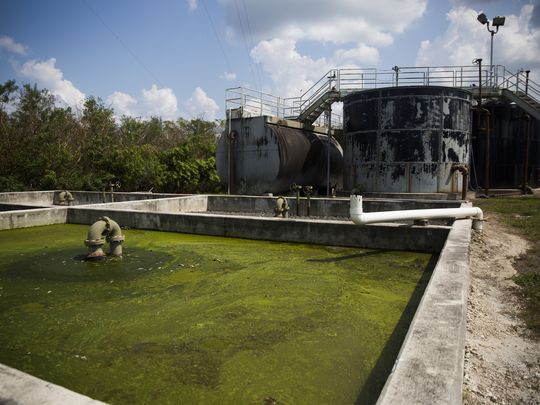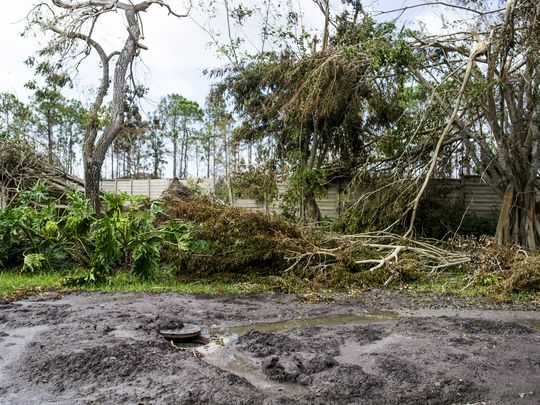Ryan Mills,Greg Stanley and Brett Murphy, Naples Published 12:03 p.m. ET Sept. 23, 2017 | Updated 10:03 p.m. ET Sept. 23, 2017
After Hurricane Irma cut the electricity to Southwest Florida, raw sewage flowed onto streets and into homes, and some residents contracted water-borne diseases, all because public utilities were not prepared to manage the massive, days-long power outage.
“I’m not sure any utility is equipped for the kind of storm we just went through,” said John Jenkins, the executive director of Bonita Springs Utilities.
More than 500 overflows across the state have dumped at least 84 million gallons of wastewater into roads, homes, parks and waterways since Florida lost power Sept. 10, with too few generators to power thousands of underground wastewater pumps in sewage systems across the state entirely dependent upon electricity.
Collier County Utilities, which serves most of unincorporated Collier County, manages 840 wastewater pump stations. All of them lost power during the storm. But just 10 percent had backup measures in place, said Beth Johnssen, the county’s wastewater director.
The sewage plant in Everglades City on Thursday, September 21, 2017. (Photo: Katie Klann/Naples Daily News)
“We’ve never seen an event where there were 840 stations without power,” she said.
Contaminated floodwater, carrying bacteria from the sea and sewage, bubbled up from the pipes before settling into neighborhoods and living rooms in Collier and Lee counties.
After wading through toxic storm surge in Everglades City — where county scientists found fecal contamination so severe it was beyond measurement — Lisa Marteeny watched her husband Lee die in a hospital from an infection that ravaged his vital organs. David Curry lost his leg after a small scrape turned black and streaked north.
It's not clear how many people in hardest-hit Southwest Florida suffered illnesses from exposure to the raw sewage. Public health officials haven’t yet compiled that data from hospitals. But local officials and emergency responders estimate dozens of residents experienced some type of adverse health condition.
Last week, Gov. Rick Scott acknowledged the lesson learned from this storm about the state’s sewer systems.
“One thing we’ve learned in these hurricanes is we’ve got to have the backup power at all of our sewer generation areas, because places like Collier County are very flat,” he said. “If you’re out of power, you’ve got to have backup power.”
Sewage on Mahogany Bend Drive in Naples on Thursday, September 14, 2017. (Photo: Justin Gilliland/Special to the Naples Daily News)
Washed in sewage
Everglades City — a harbinger for other Florida coastal communities of deadlier storms to come — did not have backup power.
But even if it did, even if the county gave the city the new backup generator it asked for, even if local officials had a disaster plan, even if the wastewater treatment plant wasn’t a rusted pile of problems, and even if that plant manager didn’t evacuate to North Carolina before Irma walloped the small fishing community that has some of the county’s poorest residents — it wouldn't have mattered much.
“That’s the whole thing that gets me,” said Tim Stephens, the manager at the treatment facility, which was the first in Florida inspected by federal engineers after Irma. “Even if this plant was brand new and had a brand-new generator, nothing’s coming in or going out when people don’t have power at their homes.”
Darryl Jones, of St. Petersburg, sprays sewage on Mahogany Bend Drive into a vacuum truck in Naples on Thursday, September 14, 2017. (Photo: Justin Gilliland/Special to the Naples Daily News)
Because of Everglade City’s low, flat orientation, gravity can’t take waste from most homes to the treatment plant. Instead, nearly every house runs an electric sewage unit called a grinder pump that looks like a trash can buried in the backyard.
But when the city lost power, the pumps shut down and waste backed up inside. Then the stormwater flooded houses, lifting the sewage out and onto streets.
The city’s electricity utility, Lee County Electric Cooperative, took more than a week to restore power to Everglades City, one of the last places in the state to get online.
During that time, residents had to use portable toilets or destroyed bathrooms overflowing with sewage and mud from nearby canals. Toilet paper and feces bubbled up like geysers just feet from where people lived.
“I try not to use the bathroom,” said Gordon Potter, whose backyard pump has a ring of used toilet paper and feces around it. “But what can you do?”
A single porte-potty in Fisherman's Cove RV Park on Thursday, September 21, 2017 in Everglades City. (Photo: Katie Klann/Naples Daily News)
Carmen Kiefer, 53, lost her mobile home to flooding in the Fisherman’s Cove neighborhood, where demolition notices are spray-painted on every other house and mountains of flood-destroyed property pile on the street.
For five days after the storm, there was no working bathroom. Residents now homeless were forced to pile their waste in a makeshift outhouse where the one public toilet had stopped flushing.
“It’s been pitiful,” Kiefer said, near tears.
The private company that installed grinder pumps in Everglades City is New York-based Environment One Corp. Company spokesman George Vorsheim said the pumps afford people a cleaner alternative to septic tanks in areas where a typical sewage system could never work.
Vorsheim said most systems would fail and flood during an event like Irma, but he could not elaborate on the specific circumstances in Everglades City or what mechanisms the pumps there have in place to prevent widespread contamination.
“It’s absolutely tragic,” he said. “It’s a severe situation.”
Sewage on Mahogany Bend Drive in Naples on Thursday, September 14, 2017. (Photo: Justin Gilliland/Special to the Naples Daily News)
Statewide overflows
As Irma made its way up the state north of Everglades City, it left behind a trail of sewage leaks that flooded roads, deluged homes and seeped into parks and waterways. Counties failed to get pumps back online before millions of gallons of wastewater poured into neighborhoods.
In Broward County, 40,000 gallons of wastewater spilled into a storm drain leading to a private lake, according to Florida Department of Environmental Protection reports. In Orange County, 438,000 gallons of wastewater were discharged in a water reclamation plant.
Nearly 4,000 gallons of diluted raw sewage leaked into Pinellas County’s Big Bayou, and 250 gallons of sewage overflowed into a Volusia County home.
Collier County’s Public Utility Division, which provides water and sewer services to a large swath of the unincorporated county, reported two dozen sanitary sewage overflows across its district.
A Collier County worker observes where sewage broke through Mahogany Bend Drive in Naples on Thursday, September 14, 2017. (Photo: Justin Gilliland/Special to the Naples Daily News)
In some cases, raw sewage poured out of manholes, covered roads and seeped into driveways and swales. Sewage bubbled up and into people’s homes.
Workers scrambled to move portable generators from pump station to pump station to keep up.
After the storm, utility leaders urged residents to cut back on their water usage, but Johnssen said, “we weren’t seeing that anywhere, that people had done that.”
Collier’s utility had backup power — a combination of bypass pumps and generators — for only about 90 of the 840 pump stations they maintain. That’s plenty of power for smaller, isolated outages, Johnssen said, but Irma’s scope was unprecedented in Collier County.
The Morning Sun Lane neighborhood in North Naples was deluged in sewage.
“It smelled like a New York subway. I could smell the urine,” said Teresa Merriwether, 56, who lives in the neighborhood.
Unlike Everglades City, more affluent cities in the area hit hard by Irma were back online within days. Most residents in those places also had the means to evacuate, so they weren’t around to overwhelm the local sewage systems.
Bob Middleton, the utilities director for Naples, said he had about 25 generators and purchased about 15 more before the storm to power their 123 pump stations. But most in the city had evacuated and weren’t flushing.
“If you don’t’ have people here,” Middleton said, “they’re not flushing their toilets and increasing your load.”
Marco Island's sewage system was without power for about 30 hours, relying on 22 portable generators for 105 pump stations.
“Had power not been restored as quickly as it was, we would have been in trouble on Marco for sure,” said Jeff Poteet, general manager of Marco’s water and sewer department.
Carmen Kiefer, a resident of Fisherman's Cove RV Park, opens the door to the public bathroom on Thursday, September 21, 2017 in Everglades City. (Photo: Katie Klann/Naples Daily News)
Hard lessons
The public health impact from the widespread sewage leaks remains unknown. Meanwhile, infections might be spreading.
Since the storm, Collier County's five hospitals have treated an average of 22 patients a day with cuts, wounds and pierces — double the daily average in the month before the storm, said Mara Gambineri, spokeswoman for the Florida Department of Health. Hospitals haven’t reported how many of those cuts have been exposed to floodwaters.
“Any time there is an open wound there is the potential for infections,” she said.
In floodwaters, the danger isn’t just sewage but also potentially deadly seaborne bacteria such as Vibrio vulnificus.
The bacteria is present year-round in many brackish and salt waters. It typically doesn’t pose a threat to healthy people as long as they don’t have open wounds or cuts. But if it infects the bloodstream, the bacteria becomes deadly.
It’s the virus that killed Lee Marteeny in Everglades City. And at least two other people in Collier County are being treated for vibriosis infections, Gambineri said.
Ideally, contamination wouldn't be a problem; wastewater systems would have standby power for all their pumps. But generators are expensive to buy and maintain, said Ken Norcross, a wastewater engineering consultant in Kansas.
Most could go years without being used, waiting for the next monster storm to hit.
“If money is no object, then of course you do it all,” he said. “But if money is an object, then you have to prioritize all the different challenges you have as a utility.”
Toilet paper from a pipe used to clean out a grinder septic tank sits in Gordon Potter's yard on Thursday, September 21, 2017 in Everglades City. (Photo: Katie Klann/Naples Daily News)
No easy solution
Doug Rankin, a Naples lawyer who served on Collier County's productivity committee in the mid-1990s, said the utility department should have been better prepared. He said he warned Collier leaders 20 years ago about the lack of planning for a major power outage. Collier Clerk Dwight Brock said he recalled Rankin raising those concerns.
“They just hoped they’d never have an outage that was more than a week,” Rankin said. “More than a week and they’d have sewers backing up into people’s houses unless they shut off the water system.”
Some utility leaders argue there isn't much that can be done because outfitting every wastewater pump with a generator is economically and logistically unfeasible.
Johnssen, Collier’s wastewater director, said an additional 10, 12, even 50 or 100 generators wouldn’t have solved Collier’s sewage problem. It would have required hundreds more.
Johnssen said she wishes they had kept people’s water off for at least one more day — a possible remedy for the next storm — but other than that, “I really think we’ve done everything we can.”
Utility leaders in Marco Island and Immokalee say they need more backup power before the next storm.
“One of my next requests for the City Council is going to be for more generators,” said Poteet, head of the Marco Island Water & Sewer Department.
The Immokalee Water and Sewer District has only three generators for its 41 pump stations, said Eva Deyo, the district’s director. That’s not enough.
“We probably do need more generators,” she said. “When a storm is coming, it’s hard to acquire them.”







